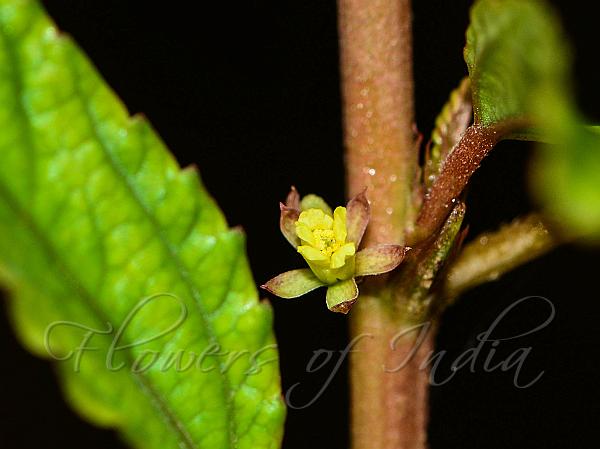|
| African Jute |
|

|

| File size | 587965 |
| Original date | 8/12/21 3:46 PM |
| Resolution | 3528 x 3196 |
| Flash | Flash fired, return detected |
| Focal length | 90.0mm |
| Exposure time | 1/200s |
| Aperture | 10.0 |
| Focus Distance | |
| Metering Mode | Multi-segment |
| Camera make | NIKON CORPORATION |
| Camera model | NIKON D7100 |
| Sensor type | OneChipColorArea |
|
|
|
|
Photo: |
Botanical name: Corchorus fascicularis Family: Tiliaceae (Falsa family)
Synonyms: Corchorus brachycarpus
Synonyms: Corchorus brachycarpus
African Jute is an annual herb with prostrate or
rising up stems up to about 60 cm long; branches hairless or with a
line of scattered setulose hairs on one side only. Leaves narrowly
lanceshaped-oblong, up to 6 cm long, basal setae absent, mostly
hairless; margin rounded toothed-sawtoothed; leaf-stalk about 7 mm
long, velvet-hairy; stipules bristly, about 5 mm long. Inflorescences
of 2-5-flowered clusters, opposite or sub-opposite the upper leaf
axils; flower-stalks 0-1 mm long, velvet-hairy; bracts bristly, about 5
mm long. Petals are yellow, slightly longer than the sepals. Stamens
are 5-10. Capsule is borne on an erect fruiting flower-stalk, more or
less cylindric, about 1-1.5 cm long, with a short beak about 1 mm.
long, quite densely hairy, many-seeded. African Jute is widespread in
tropical Africa, India and Australia.
Medicinal uses: Powder of the entire plant of
Corchorus fascicularis is used in treating anaemia. The leaves act as
laxative, stimulant, tonic and aphrodisiac. The seeds are used in the
treatment of tumours, abdominal pain, gastritis, skin diseases and
scabies. It is useful in discharging ulcers.
Powder of the entire plant of
Corchorus fascicularis is used in treating anaemia. The leaves act as
laxative, stimulant, tonic and aphrodisiac. The seeds are used in the
treatment of tumours, abdominal pain, gastritis, skin diseases and
scabies. It is useful in discharging ulcers.
Medicinal uses:
 Powder of the entire plant of
Corchorus fascicularis is used in treating anaemia. The leaves act as
laxative, stimulant, tonic and aphrodisiac. The seeds are used in the
treatment of tumours, abdominal pain, gastritis, skin diseases and
scabies. It is useful in discharging ulcers.
Powder of the entire plant of
Corchorus fascicularis is used in treating anaemia. The leaves act as
laxative, stimulant, tonic and aphrodisiac. The seeds are used in the
treatment of tumours, abdominal pain, gastritis, skin diseases and
scabies. It is useful in discharging ulcers. | Identification credit: Sushant More | Photographed in Barvi, Badlapur, Maharashtra. |
• Is this flower misidentified? If yes,